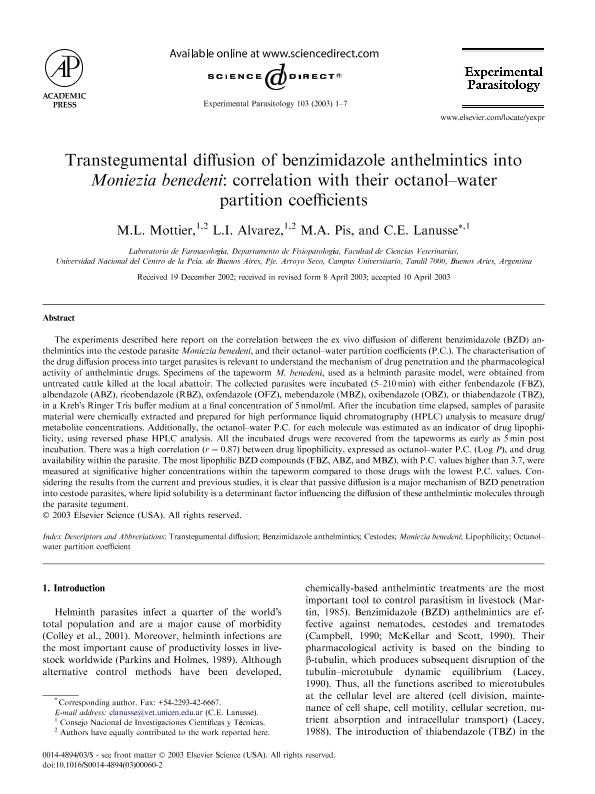Artículo
Transtegumental diffusion of benzimidazole anthelmintics into Moniezia benedeni: correlation with their octanol–water partition coefficients
Fecha de publicación:
01/2003
Editorial:
Academic Press Inc Elsevier Science
Revista:
Experimental Parasitology
ISSN:
0014-4894
e-ISSN:
1090-2449
Idioma:
Inglés
Tipo de recurso:
Artículo publicado
Clasificación temática:
Resumen
The experiments described here report on the correlation between the ex vivo diffusion of different benzimidazole (BZD) anthelmintics into the cestode parasite Moniezia benedeni, and their octanol–water partition coefficients (P.C.). The characterisation of the drug diffusion process into target parasites is relevant to understand the mechanism of drug penetration and the pharmacological activity of anthelmintic drugs. Specimens of the tapeworm M. benedeni, used as a helminth parasite model, were obtained from untreated cattle killed at the local abattoir. The collected parasites were incubated (5–210 min) with either fenbendazole (FBZ),albendazole (ABZ), ricobendazole (RBZ), oxfendazole (OFZ), mebendazole (MBZ), oxibendazole (OBZ), or thiabendazole (TBZ), in a Kreb’s Ringer Tris buffer medium at a final concentration of 5 nmol/ml. After the incubation time elapsed, samples of parasite material were chemically extracted and prepared for high performance liquid chromatography (HPLC) analysis to measure drug/metabolite concentrations. Additionally, the octanol–water P.C. for each molecule was estimated as an indicator of drug lipophilicity,using reversed phase HPLC analysis. All the incubated drugs were recovered from the tapeworms as early as 5 min post incubation. There was a high correlation (r ¼ 0:87) between drug lipophilicity, expressed as octanol–water P.C. (Log P), and drug availability within the parasite. The most lipophilic BZD compounds (FBZ, ABZ, and MBZ), with P.C. values higher than 3.7, were measured at significative higher concentrations within the tapeworm compared to those drugs with the lowest P.C. values. Considering the results from the current and previous studies, it is clear that passive diffusion is a major mechanism of BZD penetration into cestode parasites, where lipid solubility is a determinant factor influencing the diffusion of these anthelmintic molecules through the parasite tegument.
Palabras clave:
BENZIMIDAZOLE
,
ANTHELMINTICS
,
MONIEZIA BENEDENI
Archivos asociados
Licencia
Identificadores
Colecciones
Articulos(CCT - TANDIL)
Articulos de CTRO CIENTIFICO TECNOLOGICO CONICET - TANDIL
Articulos de CTRO CIENTIFICO TECNOLOGICO CONICET - TANDIL
Articulos(CIVETAN)
Articulos de CENTRO DE INVESTIGACION VETERINARIA DE TANDIL
Articulos de CENTRO DE INVESTIGACION VETERINARIA DE TANDIL
Citación
Mottier, Maria de Lourdes; Alvarez, Luis Ignacio; Pis, Ma. Alejandra; Lanusse, Carlos Edmundo; Transtegumental diffusion of benzimidazole anthelmintics into Moniezia benedeni: correlation with their octanol–water partition coefficients; Academic Press Inc Elsevier Science; Experimental Parasitology; 103; 1-2; 1-2003; 1-7
Compartir
Altmétricas




